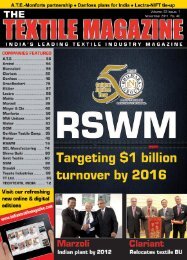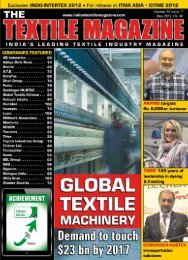policy initiatives - Textile Magazine
policy initiatives - Textile Magazine
policy initiatives - Textile Magazine
You also want an ePaper? Increase the reach of your titles
YUMPU automatically turns print PDFs into web optimized ePapers that Google loves.
technology<br />
Updated OEKO-TEX Test criteria<br />
coming into force on April 1<br />
The OEKO-TEX Association<br />
has as usual updated<br />
the applicable test criteria<br />
and limit values for testing<br />
textiles for harmful<br />
substances according to<br />
OEKO-TEX Standard 100.<br />
The new requirements will<br />
come into force on April 1.<br />
The regular re-evaluation of the<br />
test parameters is based on current<br />
market and product developments,<br />
new toxicological findings and new<br />
legal requirements, also taking into<br />
consideration the REACh legislation,<br />
including the SVHC substances<br />
relevant to textile manufacturing<br />
which have been added in 2011.<br />
The OEKO-TEX criteria catalogue<br />
stipulates the following<br />
amendments:<br />
• With respect to the current version<br />
of the REACh candidate list<br />
and the current consultations, wet<br />
spun fibres and coatings will in future<br />
be tested for n-methyl-pyrrolidone<br />
and dimethylacetamide. Both<br />
chemicals are listed in the new category<br />
“Solvent Residues” and must<br />
not exceed a limit value of 0.1%<br />
weight by weight.<br />
• In addition, relevant test samples<br />
must also be tested for four new<br />
plasticisers: di-C6-8-chain alkyl<br />
phthalates, di-C7-11-chain alkyl<br />
phthalates, di-n-hexyl phthalates<br />
(DHP) and bis(2-methoxyethyl)<br />
phthalates. These will be incorporated<br />
with the phthalates already listed<br />
in the Oeko-Tex Standard 100. The<br />
total limit value of 0.1% weight by<br />
weight shall remain unchanged.<br />
• In analogy to the existing ban<br />
on alkylphenolethoxylates (APEO)<br />
within the framework of certification<br />
of environmentally-friendly production<br />
sites according to OEKO-TEX<br />
54 | The <strong>Textile</strong> <strong>Magazine</strong> jANUARY 2012






